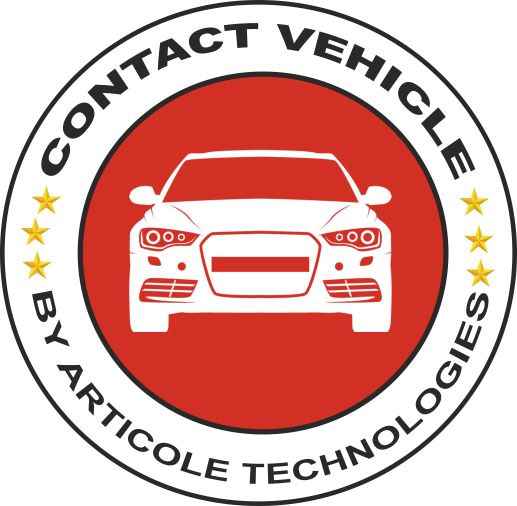Revolutionizing the Industry: How Contact Vehicle Tags are Changing the Way We Track and Manage Vehicles
In today’s fast-paced world, efficient and accurate tracking and management of vehicles is crucial for any industry. That’s where contact vehicle tags come in. These revolutionary devices are changing the way we keep tabs on our fleet, providing a seamless and reliable solution for businesses of all sizes.
With contact vehicle tags, you can say goodbye to manual record-keeping and tedious paperwork. These smart tags utilize advanced technology to monitor important vehicle data in real-time, including location, speed, and maintenance alerts. This enables fleet managers to make informed decisions that optimize operation efficiency and reduce costs.
But what sets contact vehicle tags apart from other tracking devices? Their ability to integrate seamlessly with existing systems and provide comprehensive insights. With features like geofencing and driver behavior monitoring, businesses can take control of their fleet performance like never before, enhancing safety and productivity.
Whether you’re in the transportation, logistics, or delivery industry, contact vehicle tags are revolutionizing how you track and manage your vehicles. Don’t get left behind – embrace this innovative technology to stay ahead of the competition and drive your business forward.
There is one such car safety accessories which can be purchased from https://ContactVehicle.com/Shop
Benefits of contact vehicle tags
Contact vehicle tags offer numerous benefits for businesses looking to streamline their fleet management processes. Firstly, they eliminate the need for manual record-keeping and tedious paperwork. With contact vehicle tags, all important vehicle data is monitored in real-time, providing up-to-date information on location, speed, and maintenance alerts. This enables fleet managers to make informed decisions that optimize operational efficiency and reduce costs.
Another significant advantage of contact vehicle tags is their ability to integrate seamlessly with existing systems. These smart tags can be easily connected to fleet management software, allowing for comprehensive insights and analysis. Features like geofencing and driver behavior monitoring provide businesses with the tools they need to take control of their fleet performance like never before. By enhancing safety and productivity, contact vehicle tags are revolutionizing the way businesses track and manage their vehicles.
Traditional vehicle tracking methods vs. contact vehicle tags
Before the advent of contact vehicle tags, businesses relied on traditional vehicle tracking methods such as GPS devices and manual logbooks. While these methods provided some level of tracking, they were often limited in their capabilities and required additional steps for data analysis.
Contact vehicle tags, on the other hand, offer a more advanced and efficient solution. By utilizing advanced technology, including RFID and IoT, these tags provide real-time monitoring and data collection. This allows for immediate insights and analysis, saving businesses valuable time and resources.
How contact vehicle tags work
Contact vehicle tags work by utilizing a combination of RFID (Radio Frequency Identification) and IoT (Internet of Things) technologies. Each vehicle is equipped with a contact vehicle tag, which contains a unique identifier. This tag emits a signal that is picked up by RFID readers placed strategically throughout the designated tracking areas.
When a vehicle passes within range of an RFID reader, the tag’s signal is detected, and the reader captures the vehicle’s information. This information is then transmitted to the fleet management system in real-time, providing up-to-date data on the vehicle’s location, speed, and other relevant metrics.
Use cases for contact vehicle tags in different industries
Contact vehicle tags have a wide range of applications and can benefit businesses in various industries. In the transportation industry, contact vehicle tags are used to track and manage fleets of trucks, ensuring timely deliveries and efficient routes. Logistics companies can use these tags to monitor the movement of goods and optimize supply chain processes.
In the delivery industry, contact vehicle tags provide real-time updates on the location of delivery vehicles, allowing for accurate ETA calculations and improved customer service. Even businesses outside of the transportation sector can benefit from contact vehicle tags. Construction companies, for example, can track the usage and maintenance of heavy equipment, ensuring proper utilization and minimizing downtime.
Implementing contact vehicle tags in your fleet management system
Implementing contact vehicle tags in your fleet management system requires careful planning and consideration. Firstly, you need to
Challenges and considerations when using contact vehicle tags
In today’s fast-paced world, efficient and accurate tracking and management of vehicles is crucial for any industry. That’s where contact vehicle tags come in. These revolutionary devices are changing the way we keep tabs on our fleet, providing a seamless and reliable solution for businesses of all sizes.
With contact vehicle tags, you can say goodbye to manual record-keeping and tedious paperwork. These smart tags utilize advanced technology to monitor important vehicle data in real-time, including location, speed, and maintenance alerts. This enables fleet managers to make informed decisions that optimize operation efficiency and reduce costs.
But what sets contact vehicle tags apart from other tracking devices? Their ability to integrate seamlessly with existing systems and provide comprehensive insights. With features like geofencing and driver behavior monitoring, businesses can take control of their fleet performance like never before, enhancing safety and productivity.
Whether you’re in the transportation, logistics, or delivery industry, contact vehicle tags are revolutionizing how you track and manage your vehicles. Don’t get left behind – embrace this innovative technology to stay ahead of the competition and drive your business forward.
Cost and ROI analysis of contact vehicle tags
Implementing contact vehicle tags in your fleet management system is a game-changer. These devices offer a range of benefits that can transform the way you track and manage your vehicles. From improved efficiency to enhanced safety measures, contact vehicle tags have the potential to revolutionize your fleet operations.
One of the key advantages of contact vehicle tags is their ease of installation and integration with existing systems. Unlike other tracking devices that require complex setups, contact vehicle tags can be easily mounted on vehicles and connected to your fleet management software. This means minimal disruption to your operations and a quick implementation process.
Once installed, contact vehicle tags provide real-time data on the location, speed, and performance of your vehicles. This level of visibility allows fleet managers to monitor their assets closely and make informed decisions. For example, if a vehicle is deviating from its assigned route, an alert can be triggered, enabling immediate action to be taken.
Furthermore, contact vehicle tags offer the ability to set up geofencing, which creates virtual boundaries around specific areas. This feature is particularly useful for businesses that need to track vehicles entering or leaving certain locations. By setting up geofences, fleet managers can receive alerts whenever a vehicle enters or exits a designated area, ensuring compliance and security.
In addition to location tracking, contact vehicle tags can also monitor driver behavior. By collecting data on factors such as speed, harsh braking, and idling time, fleet managers can identify risky driving habits and take appropriate measures to address them. This not only improves safety but also reduces fuel consumption and vehicle wear and tear.
Implementing contact vehicle tags in your fleet management system is a strategic move that can bring significant benefits to your business. From streamlined operations to enhanced safety measures, these devices offer a comprehensive solution for tracking and managing your vehicles.
Future trends and advancements in contact vehicle tag technology
While contact vehicle tags offer numerous advantages, there are also challenges and considerations to keep in mind when implementing this technology. Understanding these factors will help ensure a successful integration and maximize the benefits of contact vehicle tags for your fleet management system.
One of the primary challenges is data management. Contact vehicle tags generate a vast amount of real-time data, and it’s essential to have a robust system in place to handle and analyze this information. Without proper data management processes, fleet managers may struggle to extract actionable insights and make informed decisions.
Another consideration is the initial cost of implementing contact vehicle tags. While the long-term benefits outweigh the upfront investment, businesses need to carefully evaluate their budget and determine the return on investment (ROI). Conducting a cost analysis that takes into account factors such as hardware, software, and ongoing maintenance will help determine the financial viability of implementing contact vehicle tags.
Additionally, it’s crucial to consider the scalability of your fleet management system. As your business grows, you may need to expand your vehicle tracking capabilities. Therefore, choosing contact vehicle tags that can easily scale with your operations is essential to avoid the need for costly replacements or upgrades in the future.
Lastly, it’s important to address any potential resistance from employees when implementing contact vehicle tags. Change can be met with resistance, and it’s crucial to communicate the benefits of this technology and involve employees in the process. Providing training and support will help ensure a smooth transition and maximize the adoption of contact vehicle tags.
By addressing these challenges and considerations, businesses can overcome potential hurdles and successfully integrate contact vehicle tags into their fleet management system. With proper planning and implementation, the benefits of this technology can be fully realized.
Conclusion: The future of vehicle tracking with contact vehicle tags
When considering the implementation of contact vehicle tags in your fleet management system, it’s essential to conduct a thorough cost and ROI analysis. Understanding the financial implications of this technology will help you make an informed decision and ensure that the investment brings tangible benefits to your business.
The cost of contact vehicle tags can vary depending on factors such as the number of vehicles in your fleet and the features and functionality you require. It’s important to consider both the hardware and software costs associated with implementing this technology. Hardware costs include the purchase of the contact vehicle tags themselves, while software costs may include licensing fees and ongoing maintenance.
In addition to the initial investment, ongoing costs such as data management and system maintenance should also be taken into account. Proper data management processes are crucial to extract actionable insights from the real-time data collected by contact vehicle tags. This may involve investing in data analytics tools or hiring dedicated personnel to handle data analysis.
To determine the ROI of contact vehicle tags, you need to consider the potential benefits they bring to your business. These benefits can include improved operational efficiency, reduced fuel consumption, enhanced safety measures, and optimized maintenance schedules. Quantifying these benefits and comparing them to the initial and ongoing costs will help determine the financial viability of implementing contact vehicle tags.
It’s important to note that the ROI of contact vehicle tags is not solely limited to monetary gains. The increased visibility and control over your fleet can lead to improved customer satisfaction, reduced downtime, and a competitive edge in the market. These intangible benefits should also be factored into the overall ROI analysis.
By conducting a comprehensive cost and ROI analysis, businesses can make an informed decision about implementing contact vehicle tags. While the initial investment may seem significant, the long-term benefits and potential cost savings make this technology a worthwhile investment for many organizations.
Showing the single result
-

Contact Vehicle, Car and Bike Tag – Get contacted by People About Your Parked car, Keeping Your Number Private (English Stickers)
Sale! Original price was: ₹399.00.₹349.00Current price is: ₹349.00. Add to cart
Showing the single result

